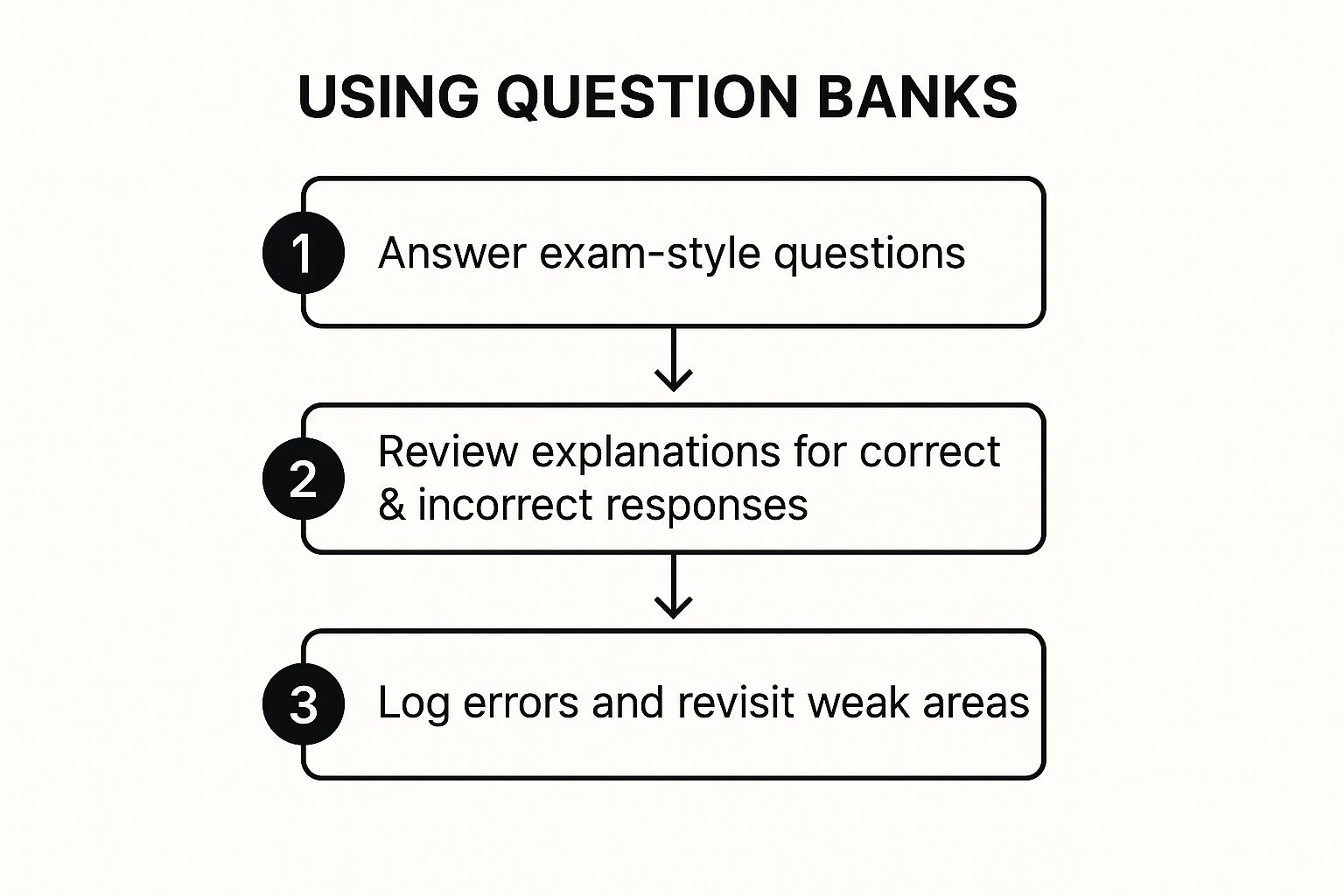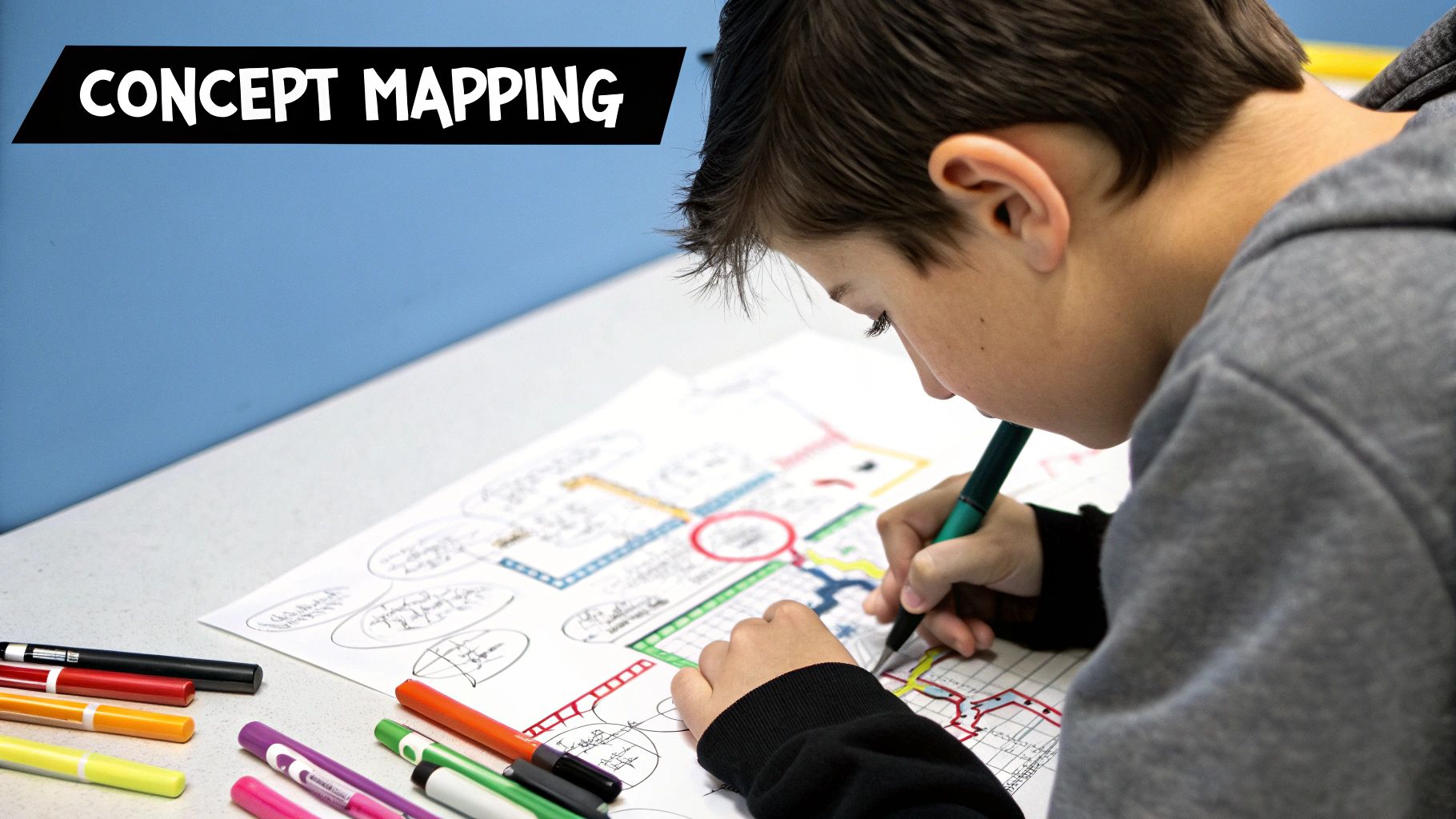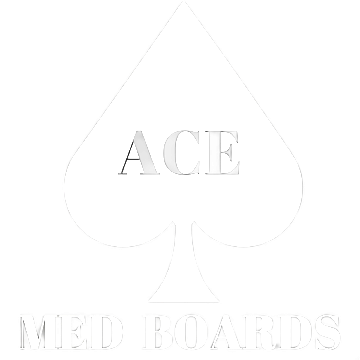The journey through medical school is less a sprint and more a marathon of intellectual endurance, demanding more than just long hours. It requires a strategic, evidence-based approach to learning. The sheer volume of information, from biochemistry pathways to clinical pharmacology, can feel overwhelming. However, the right techniques can transform your study sessions from grueling tasks into effective, high-yield activities that build lasting knowledge. This guide moves past generic advice, offering eight specific, actionable medical students study tips designed to optimize retention, boost efficiency, and help you master the material for your board exams and clinical practice.
Each strategy is backed by cognitive science and proven by top-performing students across programs like USMLE, COMLEX, and MCAT preparation. Implementing a robust framework for managing this information is just as crucial as the study methods themselves. Beyond specific study techniques, utilizing powerful organizational and note-taking tools can significantly enhance your academic performance. For example, consider exploring these 10 tips to maximize your use of Notion for academic organization to build a centralized, efficient system for your notes and schedules. This article provides a clear blueprint to not only survive but thrive. Let's explore how to study smarter, not just harder, and conquer the challenges ahead.
1. Active Recall
Active recall is a powerful study technique where you deliberately retrieve information from your memory rather than passively rereading it. This "mental workout" forces your brain to strengthen the neural connections associated with that memory, making it easier to access later. For medical students facing an overwhelming volume of information, this method is a game-changer for building durable, long-term knowledge.

Instead of highlighting or rereading a chapter on cardiac pharmacology, active recall involves closing the book and trying to write down everything you remember about beta-blockers, including their mechanisms, side effects, and clinical uses. The act of struggling to remember is what solidifies the information, a concept heavily supported by the work of cognitive psychologists like Henry Roediger and Jeffrey Karpicke.
How to Implement Active Recall
To integrate this into your routine, focus on transforming your study materials into questions. This shifts your mindset from passive consumption to active engagement.
- Flashcards (Anki): Create digital flashcards for discrete facts like drug names, enzyme deficiencies, or microbiological classifications. The front asks a question, and the back provides the answer.
- Practice Questions: After a lecture on renal physiology, immediately tackle practice questions on that topic from question banks like UWorld or AMBOSS. This forces you to apply concepts right away.
- The Feynman Technique: Choose a complex topic, like the coagulation cascade, and try to explain it in simple terms on a blank sheet of paper, as if you were teaching a classmate. This quickly reveals gaps in your understanding.
Pro-Tips for Maximum Efficacy
Making small adjustments to your active recall strategy can significantly boost its effectiveness.
- Embrace the Struggle: Don't flip to the answer immediately. Force yourself to struggle with a question for at least 15-30 seconds. This effortful retrieval is where the real learning happens.
- Combine with Spaced Repetition: Use tools like Anki that automatically schedule when you see a card again, showing you difficult concepts more frequently and easier ones less often. This combination is one of the most efficient evidence-based medical student study tips available.
2. Spaced Repetition
Spaced repetition is a learning technique that involves reviewing information at gradually increasing intervals over time. Rather than cramming, you revisit material just as you're about to forget it, which exploits the psychological "spacing effect" to optimize memory consolidation. For medical students needing to retain a vast database of knowledge for years, this method is fundamental for building a durable foundation that lasts through board exams and clinical practice.
Instead of reviewing the Krebs cycle every day for a week, spaced repetition software might show you the concept again in one day, then three days, then a week, then a month. This intelligent scheduling, popularized by software like Anki, interrupts the forgetting curve at the most efficient moment. It transforms studying from a brute-force activity into a precise, algorithm-driven process, ensuring high-yield facts stay accessible long-term.
How to Implement Spaced Repetition
The key is to use a system that automates the scheduling, allowing you to focus on the material itself. This is one of the most powerful medical students study tips for managing overwhelming content.
- Use Anki: This is the gold standard for medical students. Download a comprehensive pre-made deck like AnKing, which covers high-yield topics from major resources for board exams.
- Integrate with Note-Taking: Platforms like RemNote or Obsidian allow you to create flashcards directly within your lecture notes, which can then be reviewed using built-in spaced repetition algorithms.
- Daily Reviews: Commit to completing your scheduled reviews every single day. Consistency is crucial; a 30-minute daily session is far more effective than a four-hour session once a week.
Pro-Tips for Maximum Efficacy
Small tweaks in how you manage your spaced repetition routine can yield significant gains in efficiency and retention.
- Keep Cards Atomic: Each flashcard should test only one discrete piece of information. Avoid creating cards that ask multiple questions, as this makes it difficult to honestly assess your knowledge of each component.
- Start Day One: Don't wait until dedicated board prep to start. Begin using spaced repetition from your first block of medical school to build a compounding knowledge base over time. The earlier you begin, the more manageable your daily reviews will be. For an in-depth guide on enhancing your memory, you can learn more about how to improve memory retention.
3. Question Banks and Practice Testing
Leveraging question banks is a cornerstone of modern medical education, transitioning study from passive knowledge acquisition to active problem-solving. This technique involves systematically working through thousands of exam-style questions that simulate the format, style, and difficulty of licensing exams like the USMLE or COMLEX. It's a powerful fusion of active recall and exam simulation, enabling you to identify knowledge gaps, master test-taking strategies, and build confidence under pressure.
Instead of just reading about heart failure, you’ll tackle clinical vignettes that force you to diagnose, differentiate, and manage a patient presenting with classic symptoms. Platforms like UWorld and AMBOSS have become integral because they provide immediate, detailed explanations for every answer choice, turning each question into a valuable learning opportunity. This process solidifies high-yield information far more effectively than rereading textbooks alone.
How to Implement Question Banks
Integrating question banks effectively requires a systematic approach that begins long before your dedicated study period. The goal is to make practice testing a consistent habit.
- Early Integration: Start using a question bank like AMBOSS or USMLE-Rx alongside your preclinical coursework. After a cardiology block, do questions specifically on that system to reinforce lecture material.
- Timed, Random Blocks: As your exam date nears, switch from tutor mode to timed, random 40-question blocks. This simulates the real exam experience, building your mental stamina and time management skills.
- Create a Wrong-Answer Journal: For every incorrect question, write down the core concept you missed in your own words. This creates a personalized, high-yield review guide focused on your specific weaknesses.
The following infographic illustrates the optimal workflow for using question banks, ensuring you extract the maximum learning value from every practice session.

This simple three-step cycle transforms practice questions from a simple assessment tool into a dynamic learning engine that actively targets and corrects your knowledge gaps.
Pro-Tips for Maximum Efficacy
Small strategic adjustments can dramatically increase the return on your investment in question banks, a key component of effective medical student study tips.
- Review Every Explanation: Always read the full explanation, even for questions you answered correctly. You may have gotten it right for the wrong reason, and the explanations often contain clinical pearls related to the other answer choices.
- Don't Obsess Over Percentages: Initially, your scores may be low. Focus on learning from the explanations rather than your percentage correct. The goal is learning, not performance, especially early on. By consistently applying these methods, you can see how practice testing forms the backbone of a strong study plan. Learn more about how Question Banks and Practice Testing can elevate your scores.
4. The Feynman Technique
The Feynman Technique, named after Nobel Prize-winning physicist Richard Feynman, is a mental model for learning that tests your understanding by forcing you to explain a concept in simple terms. Instead of just memorizing facts, this method challenges you to deconstruct complex medical topics into their fundamental components, as if teaching them to a middle school student. For medical students, it is an invaluable tool for mastering intricate subjects like pathophysiology or pharmacology.
This process of simplification acts as a powerful diagnostic tool for your own knowledge. When you attempt to explain the renin-angiotensin-aldosterone system (RAAS) without jargon and find yourself stumbling, you have pinpointed the exact gaps in your comprehension. True understanding is demonstrated not by using complex vocabulary but by translating it into accessible language, a core skill for both exams and patient care.
How to Implement The Feynman Technique
Integrating this technique requires you to step out of the role of a student and into the role of a teacher. The goal is to identify weak points in your understanding by attempting to articulate concepts from scratch.
- Choose a Concept and Teach It: Select a topic, such as the mechanism of Type 2 Diabetes. Grab a whiteboard or a blank sheet of paper and explain it from start to finish as if you were teaching a friend with no medical background.
- Identify and Review Gaps: Whenever you get stuck, use jargon you can't define, or find your explanation is clunky, you've found a knowledge gap. Go back to your source material (textbooks, lectures) to review that specific point until you can explain it fluently.
- Simplify and Use Analogies: Refine your explanation. Use simple analogies to make it intuitive. For example, explain heart failure pathophysiology using a plumbing analogy of a failing pump and backed-up pipes.
- Repeat and Refine: Practice explaining the concept again to a study partner or even your non-medical roommate. Their questions will quickly reveal if your explanation is truly clear.
Pro-Tips for Maximum Efficacy
Small adjustments can turn this simple method into one of your most effective medical students study tips for building deep conceptual knowledge.
- Avoid All Jargon: The strictest rule is to avoid medical terminology at first. If you must use a term like "glomerulus," you must also be able to explain what it is and what it does in simple language.
- Record Yourself: Use your phone to record yourself explaining a topic. Listening back is an objective way to critique your own clarity, confidence, and understanding.
5. Pomodoro Technique
The Pomodoro Technique is a time-management method that systematically breaks down study sessions into focused, timed intervals. You work for a 25-minute "pomodoro" and then take a short 5-minute break. After four consecutive pomodoros, you earn a longer 15-30 minute break. This cyclical approach is one of the most effective medical students study tips for combating mental fatigue and maintaining high-level concentration during long hours of studying.

Popularized by Francesco Cirillo and advocated by productivity experts like Cal Newport, this method prevents burnout by structuring your day into manageable sprints. Instead of facing a daunting eight-hour study block for a board exam, you commit to just one 25-minute interval at a time. This lowers the barrier to getting started and helps sustain momentum throughout the day, which is crucial for the marathon that is medical school.
How to Implement the Pomodoro Technique
Integrating this technique is straightforward and requires minimal setup. The goal is to create a rhythm of intense focus followed by deliberate rest, making it a cornerstone of effective time management for med students.
- Set a Clear Goal: Before starting a 25-minute pomodoro, define a specific task. For example, "Complete 20 UWorld questions" or "Review the brachial plexus."
- Use a Timer: Employ a dedicated app like Forest or Pomofocus, or a simple physical timer, to track your intervals without distraction.
- Protect Your Breaks: Use your 5-minute breaks to completely disengage. Stand up, stretch, get water, or look out a window, but avoid checking emails or social media.
- Track Your Progress: Keep a tally of how many pomodoros you complete each day. Aiming for a specific number, such as 10-12 during a dedicated study period, can serve as a powerful motivator.
Pro-Tips for Maximum Efficacy
Simple adjustments can turn this good technique into a great one, maximizing both focus and efficiency during demanding study periods.
- Turn Off Notifications: Your 25-minute work interval should be sacred. Silence your phone and close unnecessary browser tabs to eliminate potential interruptions.
- Adjust Your Intervals: The classic 25/5 split is a starting point. Feel free to experiment with longer intervals, such as a 50-minute focus block followed by a 10-minute break, to find what best suits your attention span.
- Plan Your Day in Pomodoros: Estimate how many pomodoros each task will require. For instance, you might allocate four for a pathology chapter and three for pharmacology Anki cards.
6. Visual Learning: Concept Mapping and Drawing
Visual learning involves creating diagrams, concept maps, and illustrations to represent medical information spatially and graphically. Instead of relying only on text, this technique leverages the brain's powerful visual processing capabilities. For medical students, drawing out anatomical structures, disease pathways, and clinical algorithms transforms abstract concepts into concrete visual memories that are easier to recall during high-pressure exams.

This method is about understanding relationships, not creating art. Drawing the Krebs cycle from memory or mapping out endocrine feedback loops forces you to connect disparate facts into a cohesive whole. Platforms like Sketchy Medical and Picmonic have popularized this approach by creating memorable, story-based visual mnemonics for complex topics in pharmacology and microbiology, proving its effectiveness.
How to Implement Visual Learning
Integrating visual strategies into your study plan helps build a stronger conceptual framework for complex physiological and pathological processes.
- Concept Mapping: Start with a central topic, like "Diabetes Mellitus," and branch out to related concepts like pathophysiology, clinical features, diagnostic criteria, and treatments. Use lines and arrows to show relationships.
- Flowcharts: For diagnostic workups or management algorithms, create a step-by-step flowchart. This is perfect for mastering clinical decision-making skills needed on the wards and for exams like USMLE Step 2 CK.
- Whiteboard Drawing: Use a whiteboard to sketch out complex pathways, like the coagulation cascade, from memory. The act of drawing, erasing, and correcting actively solidifies the information.
Pro-Tips for Maximum Efficacy
Simple enhancements to your visual learning can make it one of your most valuable medical student study tips for long-term retention.
- Focus on Relationships, Not Artistry: Your drawings don’t need to be perfect. Simple stick figures and shapes are enough. The goal is to represent the connections and processes accurately.
- Use Color Strategically: Assign specific colors to recurring themes. For example, use one color for inhibitory pathways and another for excitatory ones, or use different colors for sympathetic vs. parasympathetic nerves.
7. Interleaving and Mixed Practice
Interleaving is a study strategy that involves mixing different subjects or topics within a single study session, rather than studying one topic in depth (known as "blocked practice"). This approach forces your brain to constantly retrieve different types of information and discriminate between concepts, which is far more representative of what you'll face on board exams and in clinical practice where patient problems are not neatly categorized.
Instead of dedicating an entire day to cardiology, an interleaved session might involve an hour of cardiology questions, followed by an hour of renal physiology flashcards, and then an hour reviewing pulmonary pathology. This method, highlighted by researchers like Rohrer and Taylor, might feel less productive in the short term because it's more challenging. However, it builds a more flexible and integrated knowledge base, which is a crucial component of effective medical student study tips.
How to Implement Interleaving
To effectively use interleaving, you must intentionally shuffle the content you review. This prevents your brain from getting comfortable and forces it to stay agile.
- Random Question Blocks: Use the "random" or "mixed" mode on question banks like UWorld or AMBOSS. This simulates exam conditions and forces you to switch between subjects like pharmacology, pathology, and anatomy on the fly.
- Shuffle Your Study Schedule: Instead of studying one system for three hours, break it into three 60-minute blocks dedicated to different organ systems. For example, study renal, then cardiac, then respiratory physiology.
- Mix Flashcard Decks: Rather than working through one specific Anki deck (e.g., "Cardiology Pharmacology"), create a custom study session that pulls cards from several different decks at once.
Pro-Tips for Maximum Efficacy
Properly timing and applying interleaving can make it a powerful tool in your study arsenal.
- Start with Blocked Practice: When a topic is completely new, it's okay to start with blocked practice to build a foundational understanding. After you grasp the basics, transition to interleaving to solidify the knowledge.
- Embrace the Difficulty: Interleaving feels harder because it is harder. This "desirable difficulty" is a sign that you are engaging in deeper learning and forging stronger, more adaptable neural pathways. Don't mistake the ease of blocked practice for effective studying.
8. First-Pass Learning and High-Yield Resources
First-pass learning is a strategic approach that emphasizes learning material thoroughly and correctly the first time you encounter it. Instead of consuming vast, unfiltered information from dozens of sources, this technique involves carefully selecting a few high-yield, trusted resources and mastering them. For medical students, who face a constant deluge of information, this prioritizes depth and understanding over breadth, creating a solid knowledge foundation that is easier to review and retain.
Rather than reading a dense textbook chapter, a class lecture packet, and watching three different supplementary videos on nephrotic syndrome, a student using this method would watch the relevant Pathoma video once, taking detailed notes directly into their copy of First Aid. This focused, one-time effort builds a robust initial understanding, a principle advocated by educators like Dr. Sattar of Pathoma and Dr. Jason Ryan of Boards & Beyond, whose resources are designed for this purpose.
How to Implement First-Pass Learning
The key is to be deliberate and selective with your study materials from day one. By curating your resources, you prevent the inefficiency of relearning concepts from scratch.
- Select Core Resources: Early on, choose 3-5 proven, high-yield resources. A classic combination for USMLE Step 1 is First Aid, Pathoma, Boards and Beyond, and Sketchy Medical.
- Centralize Your Notes: Use one primary resource, typically First Aid for the USMLE Step 1, as your central repository. Annotate it with key insights from lectures, question banks, and other resources.
- Engage Actively on First Pass: While watching a video or reading a chapter for the first time, don't just consume it. Create Anki cards for key facts or use the Feynman Technique to summarize the topic in your own words immediately afterward.
Pro-Tips for Maximum Efficacy
Small adjustments can make this one of the most effective medical students study tips for managing the curriculum.
- Commit to Your Choices: The fear of missing out (FOMO) is real, but constantly switching resources is counterproductive. Trust the resources that have worked for thousands of students before you.
- Use Textbooks as References: Large textbooks like Robbins or Costanzo are excellent for clarifying difficult concepts but are inefficient for primary learning. Use them like a dictionary, not a novel.
Top 8 Study Strategies Comparison
| Technique | Implementation Complexity 🔄 | Resource Requirements ⚡ | Expected Outcomes ⭐📊 | Ideal Use Cases 💡 | Key Advantages ⭐💡 |
|---|---|---|---|---|---|
| Active Recall | Moderate – requires discipline and repeated self-testing | Low to moderate – flashcards, question banks needed | High – improves long-term retention by 50-75% | Memorization-heavy subjects like anatomy, pharmacology, pathophysiology | Strong retention, identifies gaps, boosts exam confidence |
| Spaced Repetition | Moderate – set up and daily maintenance needed | Moderate – specialized software (Anki, RemNote) | High – optimizes memory consolidation, reduces study time | Long-term retention of facts like vocabulary, anatomy, drug names | Efficient time use, prevents forgetting, personalized intervals |
| Question Banks and Practice Testing | Moderate to high – requires access and systematic review | High – subscription costs (e.g., UWorld) | Very high – exam readiness, knowledge gaps pinpointed | Licensing exams preparation, test simulation | Exact exam format practice, detailed feedback, performance tracking |
| The Feynman Technique | Moderate – involves explaining and teaching concepts | Low – no special resources needed | High – deep understanding, reveals knowledge gaps | Understanding complex concepts and explaining them clearly | Builds conceptual clarity, improves communication skills |
| Pomodoro Technique | Low – easy to start with timer or app | Very low – timer or app | Moderate – improves focus, reduces burnout | Managing study time, preventing fatigue | Increases productivity, manageable study intervals, reduces procrastination |
| Visual Learning: Concept Mapping and Drawing | Moderate – time-consuming to create effective visuals | Low to moderate – paper, pens, or software tools | Moderate to high – improved memory through visuals | Complex, interconnected information like physiology, pathways | Enhances memory via visuals, clarifies relationships, engages multiple senses |
| Interleaving and Mixed Practice | Moderate – requires planning and switching topics | Low – uses existing study materials | High – improves retention and transfer by 25-50% | Mixed subjects, clinical reasoning, diverse question practice | Strengthens flexible thinking, reduces interference, simulates real clinical scenarios |
| First-Pass Learning and High-Yield Resources | Low to moderate – select and focus on few core materials | Low to moderate – limited core resources | High – solid foundation, efficient knowledge acquisition | Early study phases to build core understanding | Prevents overload, time-efficient, reduces anxiety, promotes focused learning |
Integrating Your Strategies for Peak Performance
The journey through medical school is less a sprint and more a complex marathon of continuous learning, application, and refinement. The strategies detailed in this article are not isolated tricks; they are powerful, interconnected components of a comprehensive learning system. Viewing them as a toolbox allows you to select the right tool for the right task, building a personalized framework that evolves with you from your first day of class to your final board exam.
The core principle is integration. For instance, Active Recall is the engine of your learning, but Spaced Repetition is the fuel schedule that ensures it runs efficiently over the long term. You can supercharge this duo by using Question Banks, which provide the raw material for both recall practice and identifying knowledge gaps. Similarly, when you encounter a particularly dense physiological pathway or anatomical relationship, the Feynman Technique helps you deconstruct it, while Concept Mapping allows you to visually reconstruct it, solidifying your understanding from multiple angles.
From Theory to Consistent Practice
Mastering these medical students study tips requires moving from passive understanding to active implementation. It’s about building sustainable habits. The Pomodoro Technique provides the discipline and structure to prevent burnout, ensuring that your study sessions are focused and productive. By pairing this with Interleaving, you can train your brain to become more agile, switching between different topics or question types just as you will on exam day and, eventually, in a clinical setting.
This entire system is built upon a solid foundation of First-Pass Learning with high-yield resources. By concentrating your initial efforts on what matters most, you create a strong scaffold upon which all other techniques can be applied. Wasting time on low-yield information is the enemy of efficiency, and in medical school, efficiency is paramount. As you progress, this focus on efficiency will extend beyond your studies. For example, looking ahead to your clinical years and residency, understanding innovations like the benefits of medical voice charting can help you reclaim valuable time and streamline your workflow, allowing more focus on patient care and continued learning.
Your Path Forward: Experiment and Adapt
Ultimately, there is no one-size-fits-all solution. The most successful students are those who are willing to experiment, assess what works, and adapt their approach.
- Start Small: Choose one or two new techniques to incorporate this week. Don't try to overhaul your entire system overnight.
- Track Your Progress: Notice how you feel after a study session. Are you retaining more information? Are your practice test scores improving?
- Be Flexible: What works for cardiology might not be the best approach for pharmacology. Be willing to switch up your methods based on the subject matter.
The goal is not to study harder, but to study smarter. By thoughtfully combining these evidence-based strategies, you are not just memorizing facts for an exam; you are building a deep, durable, and interconnected web of knowledge that will serve you throughout your entire medical career. This proactive approach to learning is your greatest asset in becoming a competent, confident, and successful physician.
Feeling overwhelmed or want to take your board preparation to the next level? The expert tutors at Ace Med Boards specialize in helping you integrate these very strategies to create a personalized study plan that targets your weaknesses and maximizes your scores. Visit Ace Med Boards to learn how one-on-one guidance can help you achieve your peak performance on the USMLE and COMLEX.
